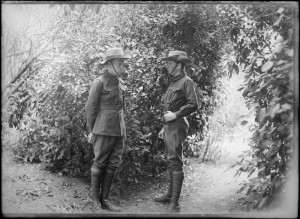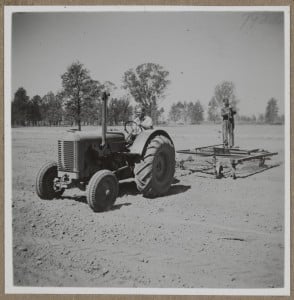A number of ongoing digitisation projects and website developments by Australian and New Zealand archive agencies means that family historians will now have greater access to the military records of their ancestors. Here are just a few of the latest developments.
John and Gus Wardell in uniform, [Vic.] H2008.2/405
Prisoner-of-war cards
The National Archives of Australia (NAA) have digitised over 4,500 records of the Australian service personnel and civilians who were captured by the Japanese during WWII. Sadly the location of the remaining 17,000 POW records is unknown.
These cards were presented to the Australian government by the Japanese government in 2012. Each card contains the details of an individual, including their name, place of birth, nationality, rank and their place and date of capture. On the reverse of each card, written in Japanese, is information about movement between camps. In some cases details about the death of the individual are recorded.
You can access the digitised records through the National Archives’ website (series A14171). For more information please contact the NAA.
Repatriation files
To mark the centenary of 1914-18, the National Archives of Australia and Archives New Zealand are digitising a sample of the First World War repatriation records of those who survived both Gallipoli and the Western Front.
Repatriation files or Department of Veterans Affairs (DVA) case files, were created for each veteran who sought the services of the department. They often included information on the veteran’s physical or mental health, the type of treatment they received and their domestic and financial situation. They help to illustrate how difficult life often was after the veteran came home.
Further information can be found on the NAA Veterans’ case files fact sheet 54.
To locate these records go to the RecordSearch page of the NAA site. Enter the name you are interested in and add the word repatriation. From the list of results select the relevant item. If the item has been digitised you will see a link to `view the digital copy’. If not, you can click on the `request copy’ link and arrange to have the files digitised.
Soldiers relaxing, Hethersett Private Repatriation Hospital, Burwood, Vic Image H2009.103/58
Mapping our Anzacs
The National Archives of Australia have also developed a new website called Mapping our Anzacs – a tool that provides access to over 370,000 World War I Australian Army service records.
On this website you will find an interactive map of the world. Search by a place name and retrieve a list of the service people who were born or enlisted in that town. Links to each individuals full service records are included where available. If you do find a person of interest you can add your own photographs or notes using the digital scrapbook tool.
Later this year this website will be replaced by the Discovering Anzacs website – a joint development between the National Archives of Australia and Archives New Zealand. The Discovering Anzacs will provide access to a unique profile of every Anzac who enlisted in World War I, including links to their service records and personal stories.
Soldier Settlement records
As part of the centenary commemoration of World War I, Public Record Office Victoria are digitising their Victorian soldier settlement records.
The soldier settlement scheme aimed to settle discharged service men on small parcels of land throughout Victoria. Between 1918 and 1934 over 11,000 returned servicemen received parcels of farming land, but by 1939 only forty percent of the soldiers remained.
PROV are currently digitising items from their VPRS 5714 Closer and Soldier Settlement and VPRS 10381 Soldier Settlement Advances files. Once digitised the records will be available online through the PROV website.
Clearing of timber and soil preparation on Murray Valley Soldier Settlement blocks RWP/7922





Hello Ann,
I am researching both my grandfathers and my wife’s grandfather WW1 ServiceRecord and medical history.
My grandfather is Robert George Manton 6314.
My wifes’s grandfather is Marshall Robert Macfarlane, he went to Rabaul, then Gallipoli and then he went to the Western Front. He returned to Australia and died from the affects of mustard gas.
We cannot ind any record on his service in Rabaul, New Guinea.
Many thanks,
Geoff And Peta Manton.
Hello Geoff, thank you for your query. There are several places you can look for information. I will email them to you directly. Regards Ann
Hello
What information can I access in Victoria that may include information on My Great Grandfather Pte Clarence Victor Prew No 3220 – 57th Battalion A.I.F in WW1.
The Australian War memorial have looked through all their held records on Nominal rolls and can find little information on him – they had stated that a number of rolls are incomplete and many of the”P’ names are missing – I have been told that all records held at AWM have been now checked against his name and there is very limited information
It is been suggested to look more locally as Pte Prew was from Port Melbourne. Are the Royal Park Military training depot files available in Victoria? Are the ship departure information available, Are the pay record books for WW1 soldiers available? What about private Diaries of WW1 soldiers? Have you any suggestions – thankyou
Hi Rosslyn, Thank you for your query. There are several sources you can try accessing. I will email them to you directly. Regards Ann
Hi Rosslyn How are you? Long time no see. Would be interested to talk with you after all these years re Prew history etc. Warmest wishes
Hi Ann,
Just came across your website. I’m looking for ways to access my grandfather, George Dalton 357/7227 (enlisted twice), post war medical records. He died in 1953 and I’ve only heard stories about his treatment for shell shock, severe skin conditions and eventual loss of an eye. Other family members say not true, so I’d like to read his files for myself. I know that he was in and out of Caulfield Military Hospital but having trouble finding out exactly who holds the records. Welcome any advice.
Nicki .
Hi Nicki, Your grandfather’s medical records would be included in his repatriation file, which are held at the National Archives of Australia. This sheet will tell you more about the records. If he has passed away, you should be able to purchase a copy of his file. Here’s a link to their contact form. Best wishes, Ann.